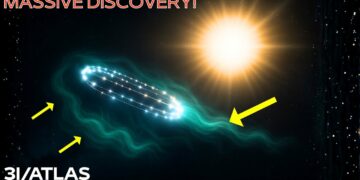Graham Hancock has spent decades exploring the mysteries of a lost civilization that, according to his theories, predates all known history. His journey began with the 1995 publication of Fingerprints of the Gods, a book that challenged mainstream archaeology by proposing an advanced civilization existed during the last Ice Age, only to be destroyed by a global cataclysm. Hancock argued this civilization influenced later cultures worldwide, leaving traces in their knowledge and structures. Despite controversy, his ideas resonated with those questioning conventional narratives. His later works, Magicians of the Gods and America Before, expanded on these claims, pointing to ancient structures, myths, and geological anomalies as evidence. However, academics often dismissed Hancock’s theories as pseudoscience, citing a lack of empirical evidence and reliance on speculative interpretations.
The Discovery That Changed Everything
In 2024, a monumental discovery in the Amazon rainforest lent unexpected support to Hancock’s theories. Archaeologists uncovered a vast underground chamber beneath an ancient city’s ruins, hidden for millennia under dense foliage and shifting rivers. This chamber, filled with intricate carvings, advanced engineering, and sophisticated artifacts, suggested a level of technological and cultural complexity previously deemed unattainable for pre-Columbian societies. Hailed as a landmark find of the 21st century, it challenged assumptions about ancient civilizations and opened new research avenues into the Americas’ prehistory, appearing to validate Hancock’s claims of advanced societies in unlikely regions.
Evidence Within the Chamber
The chamber revealed artifacts that defied conventional understanding. Stone tablets inscribed with complex symbols and geometric patterns bore striking similarities to those found in Mesopotamia and Mesoamerica, suggesting a shared knowledge system across continents. The chamber’s architecture showcased precision-cut stone blocks, some weighing tons, arranged with advanced structural techniques. Tools, polished stone blades, ceremonial objects, and intricately designed pottery indicated a culture with specialized technology and a rich artistic tradition, far beyond what was previously attributed to the region’s ancient societies.
Implications for Hancock’s Theories
The Amazon chamber’s advanced technology, shared symbolism, and architectural sophistication aligned with Hancock’s assertions of a connected, advanced ancient civilization. Critics, long dismissive of his speculative ideas, faced pressure to reconsider as the findings challenged the narrative of isolated, primitive societies. While skepticism persisted, the discovery prompted a broader re-evaluation of archaeological methods, advocating for more inclusive approaches that consider alternative explanations and the potential for paradigm-shifting discoveries.
Global Reaction
The chamber’s discovery sparked global fascination, with widespread media coverage, documentaries, and articles exploring its implications. Public interest in Hancock’s theories surged, fueling conferences and symposia where experts debated the find’s significance. The scientific community and public alike grappled with its impact on our understanding of ancient civilizations, bridging academic research and public curiosity.
The Road Ahead
The Amazon chamber marks the start of a new chapter in exploring ancient history. Ongoing excavations and analyses aim to uncover more about this civilization and its global connections. For Hancock, the find validates his lifelong work, challenging historical timelines and showcasing ancient societies’ capabilities. As research progresses, the chamber may unlock further mysteries, reshaping our understanding of human civilization’s enduring legacy.
Unveiling the Amazon Chamber
Deep in the Amazon’s uncharted jungle, archaeologists discovered a subterranean chamber beneath a forgotten city’s ruins. Sealed for thousands of years, it contained artifacts and structures that defied historical narratives, suggesting advanced societies thrived in regions once considered inhospitable. The chamber’s sophisticated engineering and artifacts challenged established timelines of human development, marking a pivotal moment in archaeology.
Architectural Wonders Beneath the Canopy
The chamber’s architecture featured precision-cut stone blocks arranged with advanced structural knowledge, some aligned with celestial events, hinting at astronomical expertise. These similarities to global ancient cultures raised questions about trade networks or cultural exchanges, redefining the Amazon’s role as a potential cradle of complex societies rather than a sparsely populated wilderness.
Artifacts That Tell a Story
The chamber’s artifacts, including stone tablets with symbols resembling those from distant civilizations, supported the idea of a global knowledge network. Ceremonial objects and finely crafted pottery revealed a society with a rich spiritual and social life, with diverse influences complicating efforts to pinpoint its origins.
Re-evaluating the Amazon’s Historical Significance
Previously viewed as a sparsely populated wilderness, the Amazon’s historical narrative shifted with this discovery. Evidence of urban planning, roads, and communal spaces suggested large, organized communities. Combined with emerging research on the Amazon’s fertile lands, this challenged assumptions that it couldn’t support dense populations or complex societies.
Connecting the Dots: Hancock’s Global Civilization Theory
Hancock’s theory of a global Ice Age civilization, outlined in Fingerprints of the Gods and Magicians of the Gods, gained traction with the chamber’s evidence. Similar motifs and engineering techniques across continents suggested knowledge transfer, lending credibility to his claims of a lost civilization influencing later cultures.
Skepticism and Criticism: A Balanced Perspective
Critics cautioned that the chamber’s artifacts, while intriguing, don’t definitively prove a global civilization, suggesting parallel development over direct contact. Archaeologist Flint Dibble emphasized rigorous, peer-reviewed analysis to avoid speculative conclusions, highlighting the need for cautious interpretation.
The Ongoing Debate: Mainstream vs. Alternative Theories
The discovery reignited tensions between mainstream archaeology and alternative theorists. Traditionalists advocated conservative interpretations, while alternative proponents saw validation of their ideas, urging a re-evaluation of historical narratives to include overlooked evidence.
Cultural Sensitivity and Ethical Considerations
The excavation raised concerns among indigenous groups about heritage exploitation and misinterpretation. They called for greater involvement and respect for traditional knowledge, emphasizing collaborative, ethical archaeology that benefits local communities.
Implications for Future Research
The chamber opens new research avenues, with plans for advanced technologies like ground-penetrating radar and satellite imagery to uncover additional sites. Integrating indigenous oral traditions with archaeological data aims to build a comprehensive picture of the Amazon’s historical landscape.
Public Fascination and Media Coverage
The discovery captivated the public, with media outlets exploring its implications through documentaries and articles. While some sensationalized the find, others offered critical analyses, underscoring the need for discernment in interpreting such discoveries.
Educational Outreach and Public Engagement
Educational programs, including workshops and exhibits, were launched to share the discovery’s significance, fostering public understanding and dialogue. These initiatives amplified indigenous perspectives, ensuring their inclusion in the broader narrative.
The Yonaguni Monument
Off Japan’s Ryukyu Islands, the submerged Yonaguni Monument, discovered in 1986, features angular steps and megaliths resembling human-made architecture. If artificial, it could predate Egypt’s pyramids, supporting Hancock’s theories. Geologist Masaki Kimura links it to the mythical Lemuria, while critics attribute it to natural geological processes, fueling ongoing debate.
The Lost City of Z: Percy Fawcett’s Quest
In the early 20th century, British explorer Percy Fawcett sought a lost city, “Z,” in Brazil’s Mato Grosso, believing it housed a complex civilization. His 1925 expedition vanished, adding mystery to the Amazon’s secrets, yet inspiring continued exploration.
The Amazon’s Emerging History
Recent discoveries, like the 2,500-year-old Upano Valley cities in Ecuador, revealed via LiDAR, show sophisticated urban networks with streets and platforms. In Brazil’s Mato Grosso, satellite imagery uncovered settlements from 1250–1500 AD, potentially housing up to a million people, challenging assumptions about the Amazon’s capacity.
The Marajoara Culture
At the Amazon’s mouth, the Marajoara culture (800–1400 AD) built large earthen mounds and produced intricate pottery, supporting populations up to 100,000 with complex social structures, exemplifying the Amazon’s potential for advanced societies.
Hancock’s Contributions and Controversies
Hancock’s books propose an Ice Age civilization destroyed by a comet 12,000 years ago, influencing early cultures. Critics argue his ideas lack evidence, dismissing the Younger Dryas impact hypothesis due to inconsistent data. His 2022 Netflix series Ancient Apocalypse popularized these theories but faced accusations of promoting pseudoscience by cherry-picking evidence.
The Role of Remote Sensing
Technologies like LiDAR have revolutionized Amazon archaeology, uncovering hidden structures beneath the canopy. The 2023 Amazonia Revelada project maps ancient settlements, aiding conservation and revealing the Amazon’s rich history.
The Intersection of Archaeology, Technology, and Conservation
Advanced technologies not only uncover the Amazon’s past but emphasize conservation. Projects like Amazonia Revelada protect newly discovered sites, balancing exploration with environmental stewardship to preserve cultural heritage.
Global Impact of Amazonian Discoveries
These findings challenge historical narratives, highlighting indigenous cultures’ sophistication. Recognizing the Amazon’s historical role fosters appreciation for its peoples and supports cultural and environmental preservation.
Conclusion: A Continually Unfolding Story
The Amazon’s history remains partly unveiled, with ongoing research and technology revealing its complexity. These discoveries illuminate human resilience and adaptability, informing contemporary challenges in cultural preservation and sustainability while enriching our understanding of the past.























